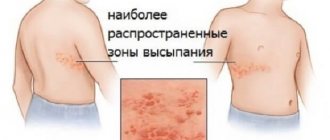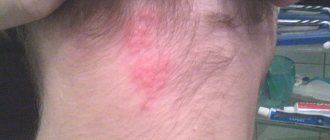Measles in adults - symptoms and treatment
Measles is an acute viral disease that is one of the most contagious and common infections. The causative agent of measles is an RNA virus of the morbillivirus genus, which is transmitted by airborne droplets. This virus has very low resistance to various influences (boiling, disinfection) and dies quite quickly outside the human body.
Although we are accustomed to thinking of measles as a common childhood disease, it is very dangerous. Every hour around the world, 15 people die from it, which amounts to 165,000 people a year. And before 1980, the number of deaths was 20 times greater! Mortality rates are particularly high in developing countries in Africa and Asia. There, 20% of child deaths are associated with measles. We managed to get rid of major measles epidemics thanks to universal vaccination. Children aged 1 and 6 years are vaccinated against measles, rubella and mumps. Even if vaccinated people get sick, they experience a mild form of the disease.
In this article we will look at measles in adults; detailed photographs of the disease will help us with this, as well as the first symptoms and current methods of treating measles; in addition, we will not forget to mention preventive measures, they will help avoid the disease and its dangerous complications.
Vaccination
In Russia, routine vaccination against measles is carried out simultaneously with vaccination against other childhood infections - mumps and rubella. The first vaccination is given to babies at the age of 12 months. At this time, the protective antibodies they received from their mothers almost completely disappear in their body. Revaccination is performed before the child enters school - at 6 years of age.
Routine measles vaccination is also carried out for all adults under 35 years of age, if they have not previously had measles and have not been vaccinated.
The best protection against measles is vaccination. Photo: Amaviel/Depositphotos
The measles vaccine is usually well tolerated. There may be side effects - a slight increase in body temperature and mild soreness at the injection site.
Revaccination - once every 10 years
Some studies show that 10 years after vaccination, the level of antibodies in the blood of 30-40% of people decreases so much that the body can no longer provide protection against measles¹. Therefore, adults are recommended to have a booster vaccination every 10 years. It is especially important for workers in the fields of education, public utilities, social protection, and healthcare.
How can you get infected?
Measles infection occurs through airborne droplets. The contagiousness index is 95%, that is, it is a highly contagious disease. To transmit the infection, direct contact with the patient is necessary; transmission of the virus practically does not occur through common things and third parties.
Cases of the disease are recorded all year round, but more often during the cold season. Children aged 4 and 5 years are most often affected. Babies under one year old who have received antibodies against the virus from their mother are immune in the first 4 months of life. In the future, the immune system weakens, and the child may become infected upon contact with a sick person. The patient remains infectious until the fifth day from the onset of the rash, and with complications until the tenth day.
The only bright spot in all this is the very powerful lifelong immunity after illness.
Diagnostics
When measles occurs in its typical form, it is not difficult to diagnose the disease. The presence of clear signs of measles described above will rule out other diseases. To make a diagnosis of an atypical form of the disease, the patient should undergo a number of additional tests:
- general blood and urine tests;
- blood test for the presence of the virus or nasopharyngeal smears (virological method);
- blood test for antibodies and increasing their titer (serological method);
- carrying out a hemagglutination inhibition reaction, which can indicate the presence of an infectious lesion.
When complications develop, the doctor additionally prescribes other tests. The most common among them are electroencephalography and chest x-ray.
Incubation period
After a pathogen (the causative agent of measles) enters the human body, the incubation period of the disease begins, which lasts 7-21 days. At this time, there are no symptoms of the disease and the patient in this phase of the disease does not complain of deterioration in health.
At the end of the incubation period and in the first 5 days of the rash, the patient is able to infect another person with the disease. After the initial stage is completed, catarrhal disease begins.
Pathomorphology
Typical in the pathomorphology of measles is damage to the epithelium of the mucous membranes and skin with the formation of symplasts, detected in the early stages of the disease. Immune-mediated cytolysis of the affected epithelium leads to destructive and inflammatory processes. Measles is characterized by serous-exudative (catarrhal) inflammation of the mucous membranes of the nasopharynx and oropharynx, larynx, trachea, bronchi, as well as the gastrointestinal tract - plethora, edema with vacuolization of epithelial cells, small lymphohistiocytic infiltrates.
Enanthema on the mucous membranes of the oral cavity, which is pathognomonic for the initial period of measles, is represented by areas of serous inflammation with superficial necrosis of the epithelium; when they are localized on the mucous membrane of the cheeks - opposite the lower molars - they are called Belsky-Filatov-Koplik spots.
During the height of the disease, an exanthema appears on the patient’s skin - a cluster of infectious dermatitis, represented by foci of exudative perivascular inflammation with histio-lymphocytic infiltration, mainly in the Malpighian layer. Diapedesis of erythrocytes into the inflammatory focus, their subsequent hemolysis with accumulation of hemosiderin, explain the subsequent pigmentation of the rash. Foci of destruction of the epithelium of the mucous membranes and skin cause subsequent pityriasis-like peeling.
In the lung tissue, cellular infiltration of the interstitial tissue, a productive-infiltrative reaction of the peribronchial and interlobular connective tissue, and impaired lymph and blood circulation are noted.
Changes in the central nervous system can manifest as measles encephalopathy caused by dyscirculatory disorders (stasis) with the subsequent development of dystrophic changes in nerve cells of a non-inflammatory nature. It is extremely rare (1 in 10,000 cases) to develop serous meningitis, encephalitis, meningoencephalitis with focal glial proliferation, perivascular lymphoplasmacytic infiltration, and foci of demyelination. The measles virus is able to penetrate nerve cells, where it is found in eosinophilic inclusions.
Measles infection can serve as an example of viral persistence. In one of 300,000 cases, 5-10 years after measles, a progressive neurological disease develops - subacute sclerosing panencephalitis (SSPE), classified as a slow viral infection. Histologically and virologically, intranuclear and cytoplasmic inclusions from which the measles virus was isolated were identified in neurons and astrocytes of patients who died from SSPE. During their lifetime, they showed high titers of antibodies to measles virus antigens.
Symptoms of measles in adults
When measles occurs in adults, the main symptoms remain the same as in children, but the severity of the disease in an adult will be more pronounced. This is especially noticeable during the period of rashes, during bacteremia, when the virus multiplies intensively in the blood.
The main symptoms of measles in adults are:
• increase in temperature (fever) up to 38 - 40 °C; • headaches, weakness; • loss of appetite; • conjunctivitis, rhinitis, photophobia; • dry, hacking cough; • hoarseness of voice; • measles enanthema – large red spots on the soft and hard palate; • rash on the skin (on the face, torso, arms, legs); • possible delirium, impaired consciousness; • intestinal dysfunction, etc.
The incubation period for measles infection lasts 1-3 weeks in adults. In the typical course of the disease, three successive stages can be distinguished: catarrhal, rash and convalescence stages.
1. Catarrhal period (initial). Measles is commonly associated with characteristic skin rashes. But the first symptoms of the disease that appear after the incubation period expires are simple manifestations of a cold: a significant increase in temperature, cough, runny nose, asthenic syndrome. At this moment, you may suspect that you have an acute respiratory infection or acute respiratory viral infection, but characteristic signs in the form of skin rashes will allow you to make a correct diagnosis.
2. Stage of formation of rashes. On the fifth day, rashes appear on a person’s skin. They spread from top to bottom - first the rash appears on the face, behind the ears, on the scalp, then spreads to the torso and arms, and then spreads to the legs. Measles manifests itself as a typical profuse bright red rash in the form of spots that tend to merge. The rash lasts on the skin for 1 - 1.5 weeks and is maculopapular in nature. The pigmentation that appears at the site of the rash also has a descending nature, that is, it appears in the direction from the head to the feet.
3. Stage of convalescence. Starting from the fifth day after the appearance of the red rash, the disease regresses and the person begins to recover. The temperature gradually decreases to normal levels, and the rash peels off. It is worth remembering that skin manifestations may disappear slowly over two weeks, while during this period of the disease the person is no longer contagious.
In adults, measles is especially severe. Pneumonia and bacterial complications are often associated with the underlying disease. Sometimes the disease can result in blindness and significant hearing loss.
One of the most dangerous complications of measles is viral meningoencephalitis (inflammation of the meninges), leading to death in 40% of cases. The measles virus greatly suppresses the immune system of an adult, as a result of which chronic diseases worsen and new ones are acquired.
Classification
Measles can be very severe and require emergency care. It is important to know that the disease can be not only typical, but also atypical:
- Mitigated (weakened) measles. The disease develops in people who were administered anti-measles gamma globulin at the very beginning of the incubation period for the purpose of prevention. It is less common in previously vaccinated individuals who have not developed a full immune response. In this form of the disease, intoxication and catarrhal symptoms of measles are mild, the rash is faint and not abundant, Belsky-Filatov-Koplik spots are often absent.
- Abortion measles. It begins in the same way as a typical form of measles. But the temperature lasts no more than two days. Skin rashes are observed only on the head and torso and do not affect the limbs.
- Hemorrhagic measles. An extremely severe form of the disease that can be fatal. It is characterized by a rise in body temperature to very high values, severe intoxication, and the appearance of hemorrhages on the skin and mucous membranes. Blood may appear in the urine - hematuria.
- Hypertoxic measles. Body temperature rises to 40–41°C. The general condition is rapidly deteriorating. Signs of cardiovascular failure appear and increase - decreased blood pressure, a sharp increase in the number of heartbeats, pale skin, cold sweat. It is possible to develop neurotoxicosis - a toxic lesion of the central nervous system. Its signs are headache, nausea, repeated vomiting, disturbances of consciousness, and convulsions³.
Measles can be very severe and fatal. Photo: PHIL CDC
Atypical course of measles
There is a typical and atypical course of measles. The typical clinical picture was described above. An atypical course is as follows:
1. Erased (mitigated) form of measles. It occurs in a very mild form and occurs with the administration of gamma globulin or immediately after vaccination against measles.
2. Hemorrhagic form - accompanied by multiple hemorrhages, bloody stool and urine. The patient often dies from bleeding. With timely hospitalization and intensive care, the outcome can be conditionally favorable.
3. Hypertoxic. Observed with increased intoxication. The patient may have a very high, persistent temperature, signs of meningoencephalitis, heart failure and other symptoms. This form requires immediate hospitalization.
Complications most often occur in adults with reduced immunity and in the elderly.
Illness in early childhood
Features of the course of measles in young children:
- Children under three months of age cannot become infected with measles - this is due to the fact that their mother passed on her immunity to them at birth. The woman herself was either vaccinated against measles or had it.
- Passive immunity, which lasts up to 6 months, protects infants at this age and they become infected extremely rarely.
- For early childhood, the atypical form of measles is more typical. There is a shortened catarrhal period, mild symptoms, the absence of Filatov-Koplik spots and enanthems on the oral mucosa. Sometimes the incubation period is replaced by a rash, and the catarrhal period is completely skipped.
- Although the symptoms in early childhood are not as severe, measles often causes complications. This is due to the fact that a weak immune system does not always know how to fight back a powerful virus that suppresses all the body’s defenses.
Treatment of measles in adults
Let’s make a reservation right away: a specific treatment that would fight the measles virus simply does not exist in nature. Therefore, treatment of measles in adults is symptomatic - it involves preventing the development of complications, alleviating the patient's condition - that is, the doctor focuses on the symptoms and fights them.
Experts advise not to take risks, monitor your health, develop immunity, get vaccinated on time, and if you get sick, immediately contact a specialist for help and under no circumstances self-medicate.
Complications
One of the distinctive features of the measles virus is its ability to suppress the immune system, which can cause many complications from a variety of systems and organs. Most often, opportunistic microflora is activated, which was always present in the child’s body, but was successfully suppressed by his immune forces.
Complications can be early and late, caused both by the virus itself (primary) and resulting from the superposition of a bacterial infection (secondary).
Complications from the respiratory system:
- pneumonia;
- bronchitis;
- bronchopneumonia;
- laryngitis;
- pleurisy.
Primary complications caused by the measles virus:
- early measles giant cell pneumonia;
- encephalitis;
- meningoencephalitis;
- subacute sclerosing panencephalitis.
Complications from the central nervous system:
- encephalitis;
- meningitis;
- polyneuritis;
- meningoencephalitis.
Complications from the digestive tract:
- stomatitis (inflammation of the oral mucosa);
- enteritis (inflammation of the small intestine);
- colitis;
- stool disorder due to increased activity of pathogenic microflora.
Complications from other organs and systems:
- conjunctivitis;
- otitis;
- blindness;
- myocarditis.
Complications from the genitourinary system:
- pyelonephritis;
- cystitis.
Unfortunately, some complications, especially from the central nervous system, can be fatal.
Stages of rashes
The rash appears 3–5 days after the first signs of the disease. It is found first on the face in front and below the ears and on the sides of the neck as uneven spots, soon mixing with papules. Within 24 to 48 hours, the rash spreads across the trunk and limbs (including the palms and feet) and begins to fade on the face.
- The fourth day of the rash is characterized by regression of the rash elements, similar to the order of their appearance, leaving behind light brown areas of increased pigmentation, disappearing after 5-7 days. At the site of pigmentation, pityriasis-like peeling remains for some time (especially on the face).








